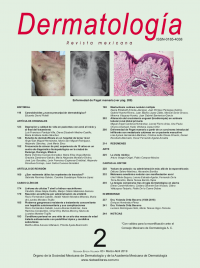Dermatol Rev Mex. 2019 marzo-abril;63(2):144-151.
Ángel San Miguel-Hernández,2 María San Miguel-Rodríguez,1 Alejandro Sánchez,1 José María Eiros3
1 Servicio de Dermatología. Hospital Universitario Gregorio Marañón, Madrid, España.
2 Servicio de Análisis Clínicos y Unidad de Investigación.
3 Servicio de Microbiología.
Hospital Universitario del Río Hortega, Valladolid, España.
Resumen
OBJETIVO: Conocer la frecuencia de aislamientos de dermatofitos en el Área Sanitaria Oeste de Valladolid, España, y contrastarla con los resultados de otros estudios y en la bibliografía.
MATERIAL Y MÉTODO: Estudio retrospectivo efectuado entre 2011 y 2017, periodo en el que se realizaron y se procesaron peticiones de muestras, como escamas dérmicas, ungueales e interdigitales. Las muestras se sembraron en tres tubos con diferentes medios de cultivo; a todas las muestras se les realizó también un examen directo con KOH a 10%. Se incubaron a 30º durante alrededor de 15 días, antes de informar el cultivo como negativo, se prolongó el tiempo de incubación.
RESULTADOS: Se procesaron 4592 peticiones de muestras, que generaron 4705 muestras. De las muestras procesadas 3045 fueron negativas y 1660 fueron positivas, es decir, se aisló algún tipo de hongo, de los que 359 fueron dermatofitos. De las 4705 muestras, 60% procedía de mujeres, de las que se aislaron 349 dermatofitos y de éstos 51.2% correspondió a varones. La tasa de positividades fue de 7.6%.
CONCLUSIÓN: El organismo aislado con más frecuencia en este medio fue Microsporum canis, al igual que ocurre en otras áreas geográficas de España y es el único dermatofito encontrado con más frecuencia en mujeres y que representa la primera causa de tinea corporis y de tinea capitis.
PALABRAS CLAVE: Dermatofitos; onicomicosis; tinea corporis; tinea capitis.
Abstract
OBJECTIVE: To know the frequency of dermatophyte isolates in the Western Sanitary Area of Valladolid and compare it with the results found in other studies and in the bibliography.
MATERIAL AND METHOD: A retrospective study was done from 2011 to 2017. During this period, requests for samples were made and processed, such as: dermal scales, nail scales and interdigital scales. The samples were seeded in three tubes with different culture media: All samples were also subjected to a direct 10% KOH test. They were incubated at 30º for about 15 days, before reporting the culture as negative, the incubation time was prolonged.
RESULTS: A total of 4592 sample requests were processed, which generated a total of 4705 samples. Of the total samples processed 3045 were negative and 1660 were positive, ie some type of fungus was isolated, of which 359 were dermatophytes. Of the total of 4705 samples, 60% were from women, of which a total of 349 dermatophytes were isolated; and of these 51.2% corresponded to males. The positivity rate was of 7.6%.
CONCLUSION: The most frequently isolated organism in our environment was Microsporum canis, as it happens in other geographical areas of Spain. And it is the only dermatophyte that we have found more frequently in women and that represents the first cause of tinea corporis and tinea capitis.
KEYWORDS: Dermatophyte; Onychomycosis; Tinea corporis; Tinea capitis.

